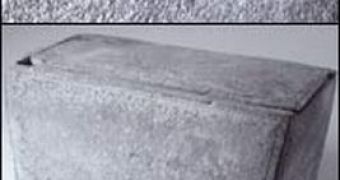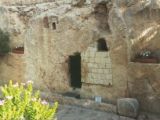"The Lost Tomb of Jesus" made by Simcha Jocobivici and James Cameron and programmed for March 04, 2007, on the Discovery Channel, has already triggered a big debate.
All this fuss started with the 1980 discovery, by the Israeli archaeologist Amos Kloner, of a tomb in the Talpiyot district of Jerusalem (photo below) while digging for building new houses.
Some 900 such tomb sites had been spotted in that Jerusalem area. 10 ossuaries (containers for the bones of the dead) with bones were found into the basement, and six had inscriptions on them.
In the 1st century Palestine people used to bury a dead enveloped in fabrics and spices, and a year or more later, the remaining bones were placed in a stone ossuary.
The discovered bones were buried by Israeli Rabbis following Jewish ritual law and fragments of the bones that were not washed out are now kept in an archeological warehouse in Jerusalem.
Another ossuary (photo above), showing no later marks of forgery and dated 20-70 CE, was found to contain the Aramaic inscription: Yaakob bar Yosef ahiw de Yeshua ("James, son of Joseph, the brother of Jesus"). This one caused quite a stir amongst the scholars. "That the box could well have belonged to James the Apostle", said Inscriptionist Andr? Lemaire of the Sorbonne. This ossuary might have come from the same Talpiyot site, which James Tabor, New Testament scholar at the University of North Carolina at Chapel Hill named it "Jesus Family Dynasty Tomb".
The six inscriptions on the Talpiyot boxes could be read like this, as the film makers argued: 1. Yeshua bar Yehosef - "Jesus son of Joseph" 2. Maria - the Latinized form of "Miriam" or Mary (mother or sister of Jesus?) 3. Yose - a form for "Joseph" (Matthew 13:54 lists 4 brothers of Jesus-James, Joses, Simon, Judas-and countless unnamed sisters) 4. Yehuda bar Yeshua-"Judah son of Jesus" (Jesus of Nazareth's son) 5. Mariamne e mara-"Miriamne the master" (Mary of Magdala's real name was Miriamne) 6. Matya-'Matthew' or 'Matthias' (could have been the husband of one of the women in one of the unmarked ossuaries)
Mitochondrial DNA tests on the bones coming from the Yeshua and Miriamne ossuaries revealed no match, so they were not relatives.
After ten years, some of the original ten ossuaries were lost. Skeptics argued that these names were common in the 1st century Jerusalem. But the film's crew and Tabor, using statistics showed that this association of names was extremely infrequent. Jerusalem's population at the time of Jesus was 50,000 (as much as the people in a medium stadium).
About 2800 were named Jesus. Of these, about 350 would have the father named Joseph; and for the mother Mary, too, would remain about 170.
With a brother named Jose would remain 23, and if we add the brother James, statistics give one result: the odds that the tomb is not of Jesus from Nazareth are 1/600 and the combination of names from Talpiyot occurs once out of 42,723,672 families.
These numbers can be biased also not only by the frequency of a particular name but on that of the cluster of names. The Talpiyot tomb upraises serious questions as to the traditional Christianism, and gives reason for many forms of incipient Christianism and Gnosticism.
Catholicism, Orthodoxy and main Christian denominations base their doctrine on the fact that Mary was a virgin at the conception of Jesus and remained a virgin and they interpret the Biblical phase "brothers and sisters" as "friends and followers."
They say Jesus never married, but scholars point to the fact that only married males could preach in the synagogue, something Jesus did.
If this is Jesus of Nazareth's ossuary and bone fragments, then the main belief in Christianity, Jesus resurrection, is challenged.
Paul says in 1 Corinthians 15: 13-14: "But if there is no resurrection of the dead, not even Christ has been raised; and if Christ has not been raised, then our preaching is vain, your faith also is vain."
These recent findings send Christians back to basics, to the Teaching of Jesus as a better way to accept Christian faith than to the later teachings and interpretations about Jesus.
But if "The Da Vinci Code" is based on fragile facts, the Talpiyot Tomb with its ossuaries and bones is a solid palpable proof.

 14 DAY TRIAL //
14 DAY TRIAL // 
